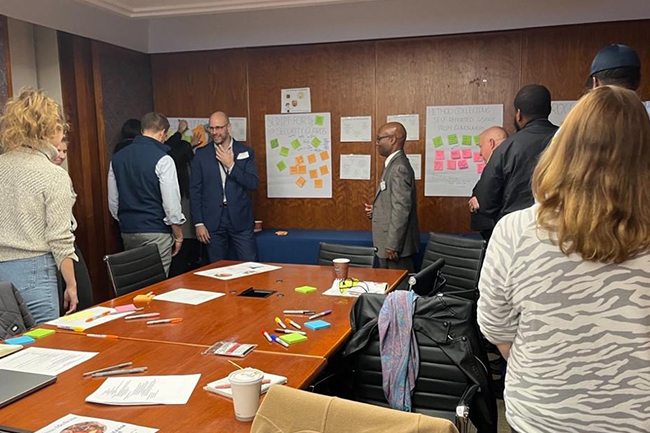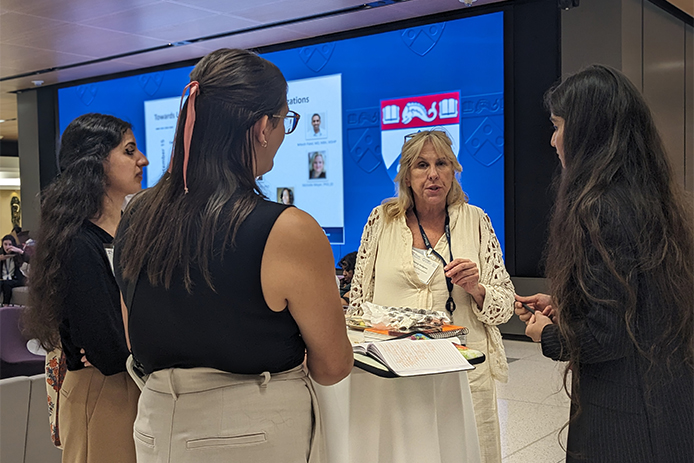Tiny flaps, big waves: Drawing parallels between the butterfly effect and health care innovation

I’ve always been fascinated by the “butterfly effect” in chaos theory – the idea that the flutter of a butterfly's wings in one corner of the world could set off a chain of events that culminates in a hurricane on the other side of the globe.
While the direct cause-and-effect relationship between a butterfly's wings and a typhoon is not realistic, the concept highlights how seemingly insignificant events can act as catalysts, influencing initial conditions and ultimately contributing to significant outcomes in a nonlinear manner within a complex system.
When I started interning at the Nudge Unit, I wondered how I could leverage design for high-impact academic projects. A butterfly delicately flapping its wings is a seemingly trivial act. Yet, in the intricate dance of chaos, it can set in motion a sequence of events that resonates through a complex web of interconnected systems. I saw this unfolding in my design projects over 12 months.
Navigating chaos creatively
Among the projects I worked on was a qualitative study to uncover the facilitators and barriers to distributing gun locks at Pennsylvania Hospital and de-risk future costly interventions. During this work, our team dealt with many unknown unknowns and ambiguity around data collection and recruitment given the busy schedules of security supervisors, whose collaboration was key.
Stakeholder management was a major learning for me. By being nimble, we managed to conduct 12 in-depth interviews with security supervisors in a day, marking a milestone for this project. Though I had a steep learning curve with using NVivo, the software we used to code the interview data and synthesize themes, it was an empowering experience to develop new skills in an agile environment.
There exists in the design world a “fear of measuring the impact of design” (FOMTIOD). Traditionally, companies measure how well things are executed: on time, on budget, or the number of features designed. However, just as it would be a herculean task to trace the cause of the hurricane to the butterfly, it can be tricky to trace the full impact of design thinking practices on an organization and project.
But, in this project, I learned the art of impact sizing and realized that the process of measuring impact is more important than the result itself.

Using a design thinking lens and tools improved our problem-solving skills and bridged gaps in our thought process. A co-design workshop with security supervisors, researchers, and hospital leadership reinforced the vision and led to the creation of long-term and short-term opportunities for education, redesign of brochures, and training scripts for security supervisors.
During the workshop, we uncovered mental models of security officers surrounding strategies for de-escalation when a gun owner refused to cooperate. A big win came in identifying scalable opportunities: Supervisors suggested we expand the safe storage program to include hospital employees and visitors not carrying guns. Security supervisors also highlighted a positive unintended consequence of the gun lock program in that we were creating a positive image for the hospital.
The final design research report that we created, coupled with the participatory workshop insights, led to the redesign of the gun locks program brochure and helped us reconsider the actual goal of having a brochure in the first place.
With the leadership of Laurel Adams and Neda Khan and the support of Arleen Lopez, we were able to make this project a success despite the unknown unknowns.
Continuous improvement and reflection
Chaos theory emphasizes continuous change. I witnessed my growth as I incorporated feedback from 1:1 meetings with team members into design deliverables and while attending the Insights to Outcomes intern training led by Dave Resnick and Jenna Moyer.
Regular check-ins with Laurel and the weekly operations meeting led by Neda, where we voiced what was going well and what wasn’t, compelled me to reflect on my progress, seek help, and prevent the planning fallacy. The 360 feedback and listening tour to collect thoughts about my strengths and weaknesses gave me perspective into areas for improvement and growth.
Writing and editing the design report and summarizing the research insights helped me hone my skills in comprehensive writing and taught me the importance of “killing your darlings.”
I learned that even seemingly minor iterative testing and refinement can cumulatively enhance overall satisfaction, which is applicable for internal team deliverables as well as end-user experiences.
I was exposed to the crucial problems of scalability, stakeholder alignment, and balancing speed with careful iteration in health care innovation. Collaborating with other interns at the Center for Health Care Transformation and Innovation inspired me to explore these avenues of design in the complex world of health care.
Working on a design sprint with Way to Health to uncover barriers and friction points, as well as the needs of clinicians, reiterated the value of delightful design and information architecture in data-driven decision-making.
I also saw the value of pre-mortems and post-mortems and how simply voicing constraints can prompt help from the team in unexpected ways, leveraging the strength of each team member.
Design without strategy is simply art. I enhanced my design skills with tools and techniques for project management and operations to take a project from zero to one.
Creating positive ripple effects
Acknowledging and celebrating small wins can boost team morale, creating a positive ripple effect across the interconnected organization. Likewise, offering affirmations and giving ownership during workshop facilitation improve the engagement and creativity of the participants. This kind of engagement enabled participants in the design workshop to share their lived experiences, which uncovered opportunity areas.
In co-facilitating the workshop, I developed the skill of defining and providing a rationale for workshop design and activity selection. Bridging gaps between different stakeholder groups and successfully translating evidence-based innovations into practice through workshops addresses an important knowledge-practice gap and improves implementation success.
Most often, workshop insights are a black box and difficult to digest. I synthesized the co-design workshop insights to create actionable and tactical design improvements, which informed the brochure redesign.
During our Nudge retreat, I realized the importance of the icebreaker – sometimes considered a trivial or unnecessary activity – in facilitating one myself. It aided in team bonding, and the “Wax and Wine” team activity that followed was a highlight of my journey with the Nudge Unit.
When serendipity meets learning
The 2023 Nudges in Health Care Symposium, organized by the Nudge Unit, brought together more than 200 people from 50 organizations nationwide to share insights about creating behaviorally enabled organizations.
Elizabeth Linos, the faculty director of The People Lab at the Harvard Kennedy School, brought a valuable perspective to light during her keynote address. She emphasized the critical role of integrating interventions with existing processes to enhance adoption and scalability. This involves aligning the new solution seamlessly with the workflows and systems already in place. The effectiveness of an intervention often depends on how well it harmonizes with the existing operational frameworks, minimizing disruptions and resistance from stakeholders.
Eric Oermann of NYU called for user experience design tools and processes to be applied in electronic health record (EHR) systems and clinician data management. Applying a user-centered lens to visualize, organize, and store data improves the experience and reduces the cognitive overload of clinicians.

Allison B. McCoy, director of Clinical Informatics Core at Vanderbilt University Medical Center, engaged the audience by talking about the Clickbusters program, which improved clinical decision support (CDS) alerts by decreasing the number of alerts triggered and subsequent user clicks. Additionally, the initiative engaged a broader user base in assessing and enhancing CDS, fostering a culture of ongoing evaluation and improvement of clinical content in the EHR.
The Nudge Unit Toolkit is a resource for practitioners and academicians interested in applying behavioral science interventions. It was a unique experience for me to conduct feedback on the toolkit via intercepts with symposium participants. We received insightful data about user needs and information architecture to improve the usability and experience of navigating the toolkit.
Overall, there were unexpected “aha” moments, and the symposium created a “Medici effect” by bringing together people across the fields of behavioral science, health care, and design for an exchange of ideas.
Connecting the dots backwards
The spirit of my journey and its parallel to the butterfly effect is acknowledging the chaos around us, especially in behavior change, and embracing it. We can navigate the intricate dance of chaos with creativity and strategic foresight, turning what might seem like chaos into opportunities for positive change.
About the author
Krishleen Kaur Kohli is an intern at the Nudge Unit and a recent graduate of Penn’s Master of Behavioral and Decision Sciences. Krishleen invites readers to connect with her via LinkedIn or email or visit her website: https://krishleenkaurkohli.com.